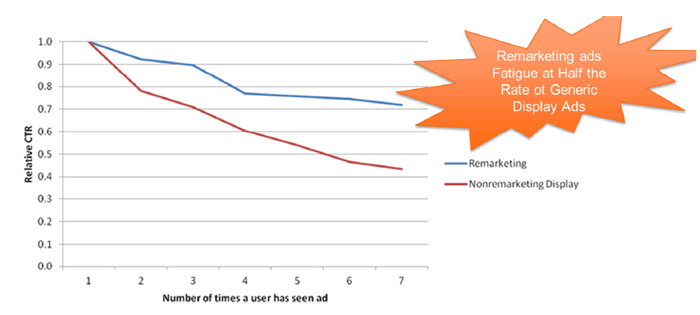
Remarketing with AdWords has trended gradually upwards over the past five years.
Interestingly, according to Google Trends, the term retargeting is also big, but is only about half as popular as the term remarketing, and is the term of choice in Russia, China and France. There are many articles about what remarketing is. This isn’t one of them. This piece is about what makes it so fascinating, and why it works, and why it sometimes might not.
Preaching to the Choir
Most AdWords advertising attempts to select an audience by various parameters, such as demographics, geography, time of day or week. Breaking that down further it goes into language, income, education. But remarketing is unique in that it creates an audience among people who in some way already know you. They have seen your website, or your email or landing page, where they picked up a pixel.
In a sense it’s similar to a 1st level connection in LinkedIn, in that they are a person that basically knows you directly in some way. Your audience for remarketing knows something of your website or company directly, and we have proof of that. They left their fingerprint at the scene.
What happens then is that your ads are shown to this audience of people on other websites across the Google Display Network, but to them it’ll be like seeing an old friend. “Don’t I know you from somewhere?” they might think, or in the case of a product ad it’ll be quite obvious. For example if you’re looking at a very specific synthesizer at GuitarCenter.com and you start seeing ads for it everywhere you go, then yeah, they are following you.
A pixel is embedded on your homepage (for example) – a pixel is a small, invisible piece of code that tells Ad Exchange to save visitors’ cookies to your “Homepage” list. As people visit your homepage, their cookie is added to the user list. You can then create a campaign in Ad Exchange that targets messages only to visitors whose cookies are on this list. Your remarketing messages is not shown to people whose cookies are not on the “Homepage” list.
Further on Down the Funnel
But your retargeted audience is much smaller than say, a wide open display network campaign whose goal is to increase brand awareness. Those campaigns don’t expect a high CTR (click through rate) because they aren’t as tightly targeted. But a remarketing campaign reaches people who have already taken a step into your world; they entered your funnel as it were, and you already have them. There was no need to capture their email and get them to convert on a landing page or sign up to a mailing list. You already have their eyeballs.
But is that enough? Just because a person has visited your website doesn’t mean they’re necessarily a good fit or even in your target market.
Super-Remarketing on Facebook and Twitter
One writer from Wordstream believes he coined this new term, which he defines as being remarketing run through Facebook and Twitter, where you can further define your market by:
- behavioral and interest targeting
- recent visitors
- AND by economic demographic targeting.
Now we’re not just remarketing to anyone who has somehow acquired the pixel. We then refine the audience further using the tools of these social media giants. You’ll be showing your ad there on Facebook to people who have visited your website, IF they further fit into your demographic, behavioral and economic criteria. I would call it remarketing plus plus.
Can you imagine if TV or radio advertising was like this? You wouldn’t have to watch yet another ad about a prescription medicine that has nothing to do with you. You’d be watching ads on the latest guitar pedal, or video game, if that’s your thing.

How Much is Too Much?
If you’ve ever been stalked by a particular company, or one of their products, then you know what I mean. Look folks, I was on your website for a completely different reason, OK? Stop following me!
On the Kissmetrics blog this topic was expliored back in 2016. The article explored the idea that retargeting could actually be sabotaging your sales. What are the elements and factors to watch out for?
Factors such as trust in the advertiser, and one’s stage in the buying process become very important. People who are still in the research phase of the buying cycle are more likely to welcome a company’s retargeted ad, vs the ones who are in a post-purchase phase. Or maybe they see that ad on an unrelated site, such as one about motorcycles, and that dentistry ad may not be too welcome.
What the article doesn’t explore though, or admit, is that ads are in general a kind of necessary evil. Some people are hostile towards ads in general as a matter of principle, and to varying degrees. In such cases it doesn’t matter that it’s a retargeted ad at all. Plus they are going to see some ad in that space one way or another. That’s the website’s choice, and visitors understand and accept that. But the article does admit to there being a fine line “between trust and privacy.”
Wordstream states that remarketing ads actually fatigue at half the rate of generic display ads, and that conversion rates actually increase with more ad impressions. Thus, while it’s good to be mindful of your audience and to avoid “abusing” them, the fact is that remarketing works. It really does pull the rabbit out of the hat as it were. To me it’s remarkable, because in general the sites I’ve been visiting are the things I’m interested in anyway, so I don’t mind seeing a retargeted ad. In fact I sort of welcome seeing that Korg synthesizer again. It’s a happy thought. And let’s face it, remarketing won’t show you ads from websites where you haven’t been. So it’s personal, it’s 21st century, and it’s here to stay.
Ladies and Gentlemen…. REMARKET!
http://www.inskinmedia.com/wp-content/uploads/PR-Graph1.png
https://blog.kissmetrics.com/retargeting-myth/
https://blog.kissmetrics.com/wp-content/uploads/2015/05/Reaction-to-frequency-of-retargeted-online-ads.png
https://www.wordstream.com/blog/ws/2015/10/01/remarketing-facts
Blaine Fallis
Latest posts by Blaine Fallis (see all)
- A Tale of Three Transactions - July 9, 2018
- Becoming GDPR Compliant - June 5, 2018
- What is it about Remarketing? - April 21, 2018
